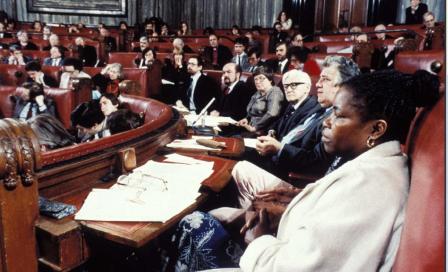
The movement came about as a result of two distinct yet converging impulses. The first was the desire among the migrant population to change the conditions of deprivation and discrimination in which most of them lived. The second was a cautious attempt by local authorities and central government to recruit migrant assistance in tackling the same conditions, while broadening their own base of political support within these communities.
Throughout the 1960s, the legislation which limited immigration from the New Commonwealth ran parallel to legislation which gradually outlawed racial discrimination. In the mid-1960s the body that had an ostensible brief to manage ‘race relations’ was the Community Relaions Commission (CRC). Within the community of Caribbean migrants, however, there was an atmosphere of distrust towards the entire idea of ‘race relations’. The CRC was attacked for implementing what was seen, within the migrant community, as an essentially colonialist strategy, and was dismissed as benevolent patronage which ghettoised migrant interests. Throughout the 1960s various migrant groups vigorously lobbied the government for a different approach.
During the late 1960s, Powellism had provoked a storm of public hostility towards migrants.
At that time, local authorities were faced with a range of traditional problems – decaying housing, growing educational needs, and a decline of industry. Public opinion focused on the migrants as being contributory and local councils began demanding increased resources for what were seen as the problems migrants brought with them.
The government response to both of these demands was to collect various budget streams under one heading which it called the ‘Urban Programme’, and offer these funds to local authorities who could demonstrate ‘special social need’. This allowed local authorities to sponsor local voluntary groups to run hostels, playgroups, supplementary schools, advice centres and a range of similar projects. The result was a network of projects grouped around the problems for which the welfare system and the local authorities had yet found no answers. Increased local authority funding therefore provided the opportunity for the growth of a network of projects. Priority issues were:
- Homelessness among young Black people emerging from local authority care and the prison system
- The results of alienation and failure in the school system
- Conflict between young Black people and the criminal justice system
- Cultural expression reflecting the experience of those coming from the Caribbean or from Caribbean roots and growing up in England
The projects tended to be the product of local needs and were usually run by committed activists who emerged from the migrant community to form independent groups. This meant that these groups were also usually made up of the most politically committed and highly motivated people in the community. The titles of some of the major project tells the story: Harambee, Bogle L’Ouverture, Dashiki, The Melting Pot Foundation, Ujimaa, George Jackson House, and so on. The names were chosen to invoke the mood of radical rebelliousness in Africa and the Black diaspora, but the work of these enterprises was by and large to do with filling the gaps left by the authorities in the areas of welfare and education.
The network of projects resulting from the movement was, however, a crucially important sounding board and amplifier within the Black communities. It helped shape migrant opinion and established an internal market, not only for ideas, but also for styles, for behaviour, and for various kinds of cultural products. For instance, the movement established ‘Black’ bookshops in all the major centres, and books such as Bernard Coard’s How the English School System Makes West Indian Children Educationally Subnormal, or Walter Rodney’s How Europe Underdeveloped Africa, or Linton Kwesi Johnson’s Dread Beat and Blood, became bestsellers solely on the basis of their sales within the community. The authors and their ideas were eagerly circulated and listened to in this milieu, and in much the same way the projects expanded and reinforced the market for Black music, art and poetry, providing venues and audiences for Black artists and speakers.
In addition, the projects functioned as a kind of newsstand, disseminating information about demonstrations, rallies and festivals all over the country. At the other end of the scale Self Help offered a number of Black people their first experience of administration and management, from which several went on to become involved in local authorities and local politics.
The Self Help Movement turned out to be a victim of its own success. By the start of the 1980s local councils were employing the same speakers and teachers who had been part of the projects. The Self Help people were being recruited as school governors or local authority managers. The authors, poets and academics were moving into universities here or, more usually, abroad. The music was being taken over by corporate interests and white audiences. The dramatists and actors were becoming part of the mainstream of English theatre or television. The political activists were about to become local or national politicians. By the end of the 1980s, the functions and the personnel which had made up the Self Help Movement had created their own niches in British society, and the politics had moved on.
